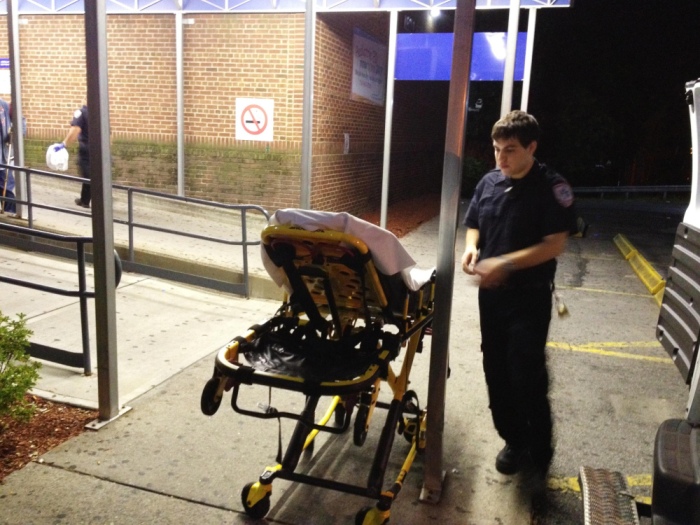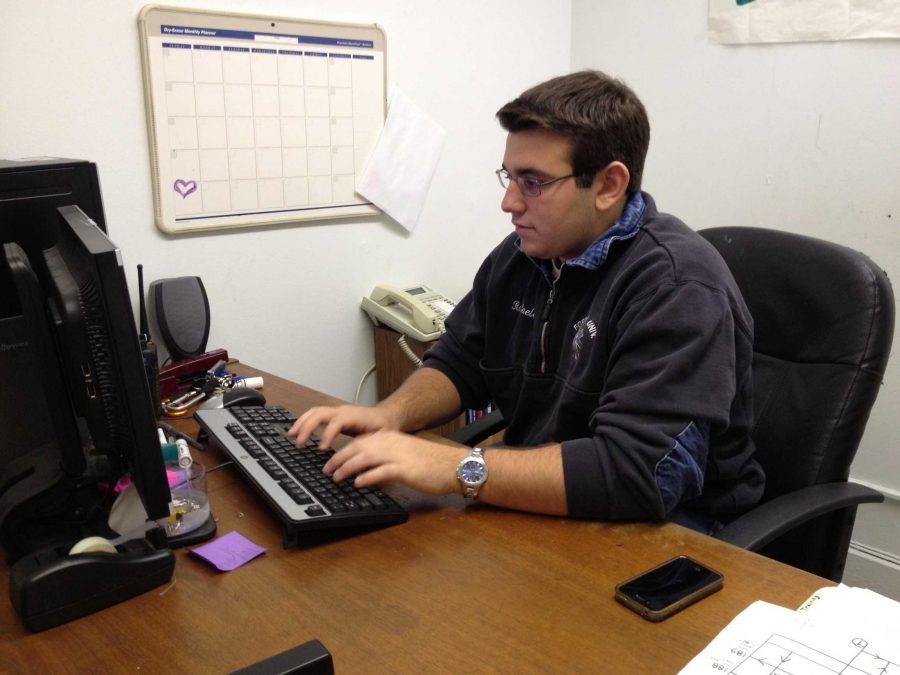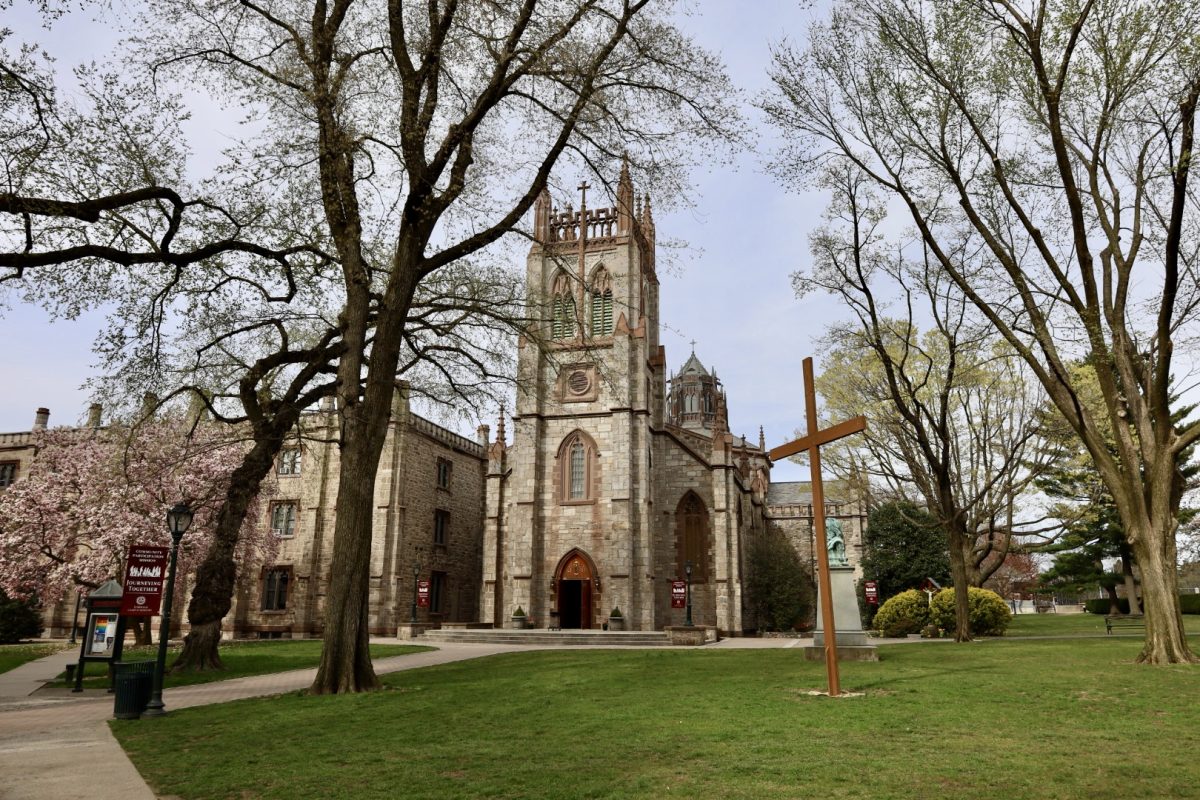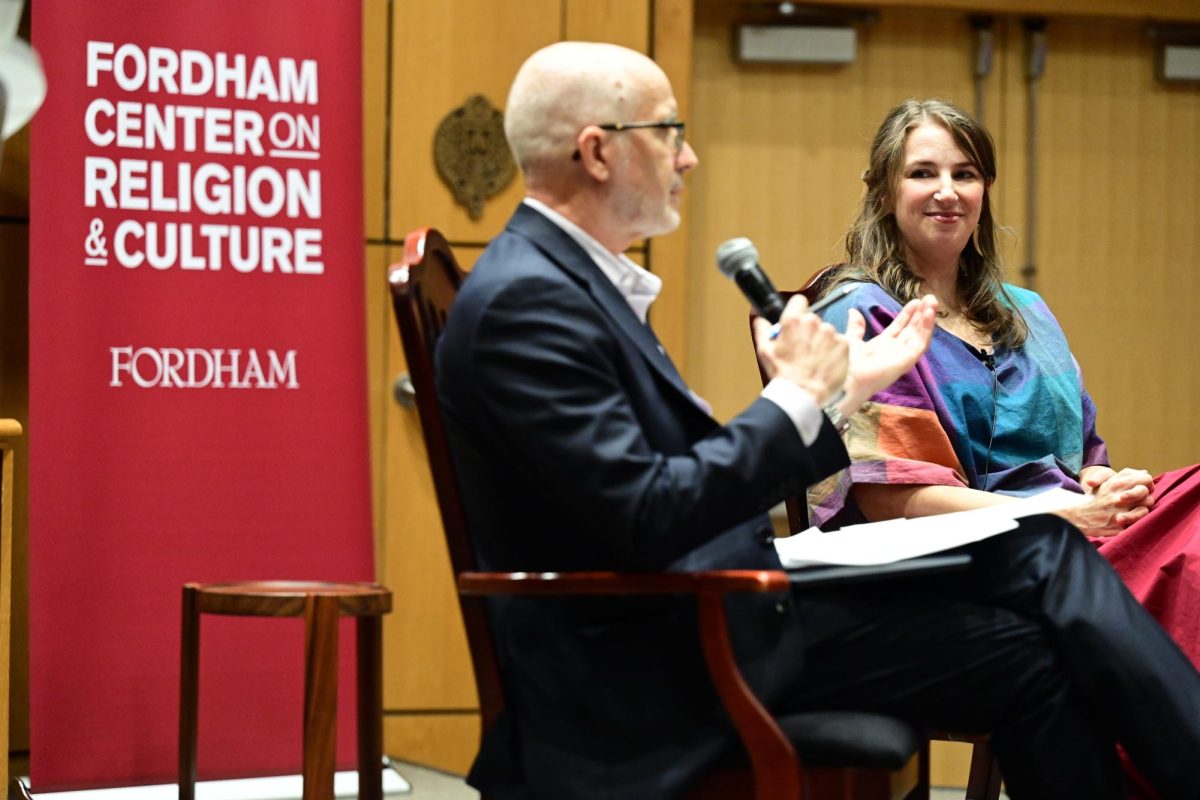
By CONNOR RYAN
It was right before midnight on a brisk Friday night. The crew had just gotten back to campus after a quick trip to the nearby 7-Eleven for chips and soda — a convenient and fulfilling sustenance, they say . The three students on duty then simultaneously received a call, from a dispatcher in the Office of Safety and Security, as they walked through the door of the Fordham University Emergency Medical Service (FUEMS) office.
It was the third call of the night, but the first “intox,” or intoxicated person, notification.
They tossed their snacks on an already crowded table and the crew was back out the door. The conversation hushed as everyone assumed their respective duties and got into “Rig One,” the newer of the two ambulances that FUEMS uses.
As Rob Raffaele, FCRH ’15 and first lieutenant, quickly rounded the corner to bring the ambulance onto the narrow road behind Salice-Conley Hall, he subtly turned up the radio. A pop song was playing, and he quietly hummed along.
Jim Benischeck, FCRH ’14 and second lieutenant, and Bryan Galligan, FCRH ’15 and administrative officer, were in the back of the ambulance taking final inventory and preparing the Patient Care Report (PCR) for easy access.
The nature of the call was unknown — as it often is — but the atmosphere inside the ambulance remained composed and focused.
Like starting basketball players before a big playoff game, the crew was getting into the zone.
A male freshman, clearly intoxicated and whose identity has been withheld to maintain confidentiality, was sitting in the bushes near a residence hall. A security guard and a girl in a tight, white skirt were standing over him.
She said that the two of them had been drinking earlier that night at Barstool Blackout, a nationwide college concert tour, in Manhattan. He apparently had 14 or 15 drinks, mostly vodka, before returning back to campus and collapsing. She said that he might have fallen, but later confirmed that he did not hit his head.
After the student vomited in front of the crew, they loaded him into the ambulance and prepared to transport him to St. Barnabas Hospital — one of the hospitals to which FUEMS transports patients. (FUEMS also transports to Montefiore Hospital and the Jacobi Medical Center, depending on the call.)
Before moving out, Galligan asked the patient to provide some basic information (such as his home address and telephone number) for the PCR, which must be filled out with every FUEMS call. The student spoke mostly incoherently as he floated in and out of consciousness, vomiting every few minutes into a plastic red bag fastened around his neck. When he did speak, he pleaded that the crew not call his parents and later apologized to them. He pledged that he would never drink that much again. Galligan assured him that the crew would not call his parents.
Benischeck took the student’s blood pressure, pulse, blood oxygen saturation and pupil response — standard vitals. Then, Raffaele was given the green light to go.
Just as the ambulance began moving, Benischeck asked the student about his night and whether he thought the concert had been worth it.
“No…it wasn’t worth it,” the student said quietly. He was convinced he was still sitting at the bar.
6:18 p.m.
The Friday night crew has already assembled in the FUEMS office, located beneath Queen’s Court. Maeve Bassett, FCRH ’14 and Director of Fordham EMS, is in the office ready to check supply levels. The crew will also do a “Rig Check” at the start of every shift, during which they check the supplies in the ambulance, as well as the exterior emergency lights.
The back of the ambulance is tight, but well organized. Each bandage, roll of medical tape and tool has a designated nook or cabinet.
The crew prides itself on maintaining a full inventory and knowing exactly where everything is.
The biggest items of note are two bags. One, called the “Jump Bag,” contains bandages and first-aid materials. The second contains an oxygen canister and tools related to oxygen administration including albuterol, which is often used on asthmatic patients.
The ambulance also carries a suction system, to be used in the event of profuse vomiting or any compromised airway, a defibrillator and a backboard.
6:35 p.m.
Raffaele is in the driver’s seat of the ambulance. He does a radio check with the Mutual Aide Response System (MARS), which FUEMS calls if additional resources are needed. FUEMS is a Basic Life Support service (as are most FDNY units). FUEMS may radio MARS if a higher medical authority is required on a call.
Bassett, Galligan and Benischeck sit in the back of the ambulance.
“Good to go?” Raffaele asks the three in the back. They give him the all-clear and the ambulance begins to move. Its next destination is Wendy’s.
7:00 p.m.
The ambulance smells like French fries. The conversation flows easily and laughter is almost constant in the back of the ambulance as it pulls out of the Wendy’s parking lot.
It soon becomes apparent that the ambulance is about as bumpy a ride as the typical Ram Van, and that preventing a large soda from spilling is undoubtedly a respected skill.
“Rig Two,” the older ambulance that FUEMS brought into Manhattan on September 11, will soon be replaced. (The crew is very excited about that.)
7:15 p.m.
The ambulance stops in front of Best Deli (another dinner option). While Bassett runs inside, the others stay in the ambulance and the conversation ranges from a particularly difficult Organic Chemistry quiz to some funny moments on past calls.
7:30 p.m.
After eating as a group at a long table in the main room of the office, Raffaele escapes to a smaller office to review previous PCRs. For every call that FUEMS responds to, a PCR has to be filled out. The nature of the call, a short assessment of the patient, patient information (including his or her vital signs) and the treatment received are all included in the form. Raffaele says part of his job is to review past calls to see how FUEMS could be improved and ensure that they maintain a high quality of care.
After every call, FUEMS contacts Kathleen Malara, executive director of University Health Services, or Deborah Mosko, assistant director of Health Services, to report the incident. Malara and Mosko use that information to follow-up with the patient the next day.
Despite the fear many students have about FUEMS calling their parents, Bassett said that because FUEMS is bound by the Health Insurance Portability and Accountability Act (HIPAA), they cannot tell anyone about the specifics of any call. Employees at the Student Health Center are also bound by that confidentiality agreement.
HIPAA prohibits medical personnel from revealing details about a call. That does not apply, however, when medical professionals contact other professionals to discuss a case. Details from cases may be used in training environments, but the identities of patients are never discussed.
Bassett says that she has tried to dispel rumors and common misconceptions at the mandatory Campus Assault and Relationship Education (CARE) programming. All students are required to go through the program their freshman year.
“Just going to the hospital is scary enough, but being in a prestigious school where a lot of it depends on your record, anything that could put a bad mark on your record is scary to a lot of people,” Bassett said later in an interview. “During the CARE programming, I focus on our medical amnesty policy.”
Raffaele says he is well aware that many students do not want to call FUEMS, for themselves or for friends, in fear of getting into trouble. His response is direct.
“If you are afraid to call for your friend because you think you’re going to get into trouble and your friend doesn’t wake up in the morning, then it really doesn’t matter whether you got documented or not,” Raffaele said later in an interview.
As it turns out, Fordham’s medical amnesty policy states that if a student calls FUEMS for another student, the student who called cannot get into trouble. Also, the first time that a student is taken to the hospital because of substance abuse, they do not get into disciplinary trouble. They do, however, have to meet with an administrator from Fordham’s Office of Substance Abuse Prevention and Student Support.
“The best way anybody can help us is if they see someone who needs help to call us,” Raffaele said. In the event of an emergency, contact FUEMS at (718) 817-2222.
8:09 p.m.
Light conversation continues in the office. Then, a switch is flipped as the first call of the night comes through the radio. A rugby player has injured his knee in a game on Murphy Field.
“It’s a very harsh switch from joking around to ‘OK, we’re on a job now,’” Raffaele said of the adrenaline-inducing transformation.
The three crew members (Bassett was not on duty at the time) are next to the injured player in a matter of minutes. Galligan asks for basic information while Benischeck takes the player’s vitals. It is quickly determined that a simple dressing will be the best course of action. The crew, with the patient’s consent, determines that a trip to the hospital is not needed.
After getting the last bit of information from the 21-year-old athlete, the crew waits 15 minutes before leaving the field, per protocol.
8:39 p.m.
Men in Black is on the TV in the office. Bassett is curled up on one of the three couches in the office. The more-experienced Raffaele talks to Galligan about the call, and what could be done to improve the process going forward. Benischeck contributes to the conversation briefly and then sits down to watch the movie.
9:16 p.m.
A security dispatcher pipes through the radio once again. Another rugby player is hurt.
The crew returns to Murphy Field, this time to help a player who has a laceration just above his left eyebrow. He sustained the injury after colliding heads with another player on the field. The same structural protocol from the last call is followed again. Galligan cleans and dresses the wound.
11:15 p.m.
After going to the nearby 7-Eleven for some snacks, the crew drives by various local bars to take a look at the traffic as they try to gauge how busy the night will be. Raffaele later said that those kinds of trips are fairly regular.
There are 11 officers, roughly 25 crew chief drivers, nearly 50 EMTs and drivers and more than 60 attendants (new members) currently working at FUEMS. Despite the long hours and the difficult circumstances students are often thrown into, the organization is completely student-run and volunteer-based.
Malara, however, feels as though the students who work should be compensated in some way.
“I would like to see the student volunteers compensated somehow, either early registration, food vouchers, books, room and board or just a stipend,” Malara said in an email. “Students should know and understand that these student volunteers are first and foremost students themselves, that they deserve respect and that they are bound by confidentiality regarding transports.”
12:30 p.m.
The crew waits in the emergency room of Barnabas. The patient from the first “intox” call of the night is sitting up, but dozing, on a stretcher pushed off to the side. Benischeck and the student’s friend stay next to the stretcher. Galligan and Raffaele brief the receiving nurse. Just about every bed in sight is occupied.
The student stays on the stretcher, waiting in line to be triaged. Finally, a nurse comes to the student and takes his vitals. Raffaele provides the nurse with more information about the student’s condition. The student is eventually moved into the pediatric unit. His friend’s high heels click down one of the hospital’s many glossy hallways as she closely follows the stretcher.
As the crew leaves the hospital, a police officer sitting in the emergency room is speaking with a hospital worker. He quietly comments about Fordham’s cost of tuition and the amount of intoxicated students he sees come through the hospital.
4:20 a.m.
The second “intox” call of the night comes through the radio – this time, it is at an off-campus residence.
The crew walks up three flights of stairs to the apartment where the intoxicated student is located. The small apartment smells of smoke and there are more than 15 beer cans on the kitchen table.
In order to get the student into the ambulance, the crew uses a stair chair (a small wheelchair used to transport patients on stairs). Taking it one step at a time, the crew gets the student out of the building, onto the stretcher and into the ambulance.
As the crew is putting the student into the ambulance, a friend of the intoxicated student slowly wanders over. She says she was with him earlier in the night, but then left. She says she didn’t want him to go to the hospital alone, but said she was concerned about calling for help in fear of losing her scholarship.
“I’m so sorry … Oh, my God … Thank you God,” the intoxicated student says in the ambulance en route to Barnabas.
“It’s OK,” Benischeck replies. “We’re just making sure you’re safe.”
5:15 a.m.
The intoxicated student has been triaged at Barnabas and is waiting to be moved to a bed. He is not vomiting, but he is clearly disoriented. His friend, clutching a trendy bag, stands nervously by the stretcher.
A young woman is lying on a stretcher next to the Fordham student, coming in and out of what appears to be a painful sleep. She has been taken in by Barnabas EMS and is seriously intoxicated.
She wears heels, jeans and a stylish shirt. Her bright red lipstick is fading fast as a creamy-white liquid slowly falls out of her open mouth. Her eyes are closed and her body is still, but her silver jewelry glistens in the fluorescent lights of the emergency room.






































































































































































































